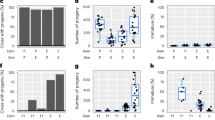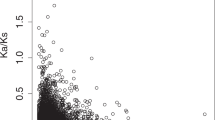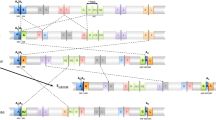Abstract
SPECIATION is the primary process of cladogenetic evolution. It is generally agreed that genetic divergence sufficient to produce reproductive isolation among populations is acquired in the allopatric state1–4. One of the major problems of evolutionary genetics is, then, characterisation of the genetic differences which actually produce the reproductive and sexual isolation characteristic of species. A partial answer to this problem has been provided by estimating the degree of structural gene divergence over various taxonomic levels—populations, subspecies, semispecies, sibling species and morphologically distinguishable species5,6. The general picture emerging from these studies is moderate structural gene differentiation at the subspecies level. Once reproductive isolation has been achieved, little additional change seems to be required to establish sexual isolation between subspecies. There are, however, exceptions to this generalisation7,9, and they do not seem to be infrequent. Speciation may occur as a result of chromosomal rearrangements, accompanied by little, if any, detectable change in the structural genes usually studied.
This is a preview of subscription content, access via your institution
Access options
Subscribe to this journal
Receive 51 print issues and online access
$199.00 per year
only $3.90 per issue
Buy this article
- Purchase on Springer Link
- Instant access to full article PDF
Prices may be subject to local taxes which are calculated during checkout
Similar content being viewed by others
References
Mayr, E., Animal Species and Evolution (Belknap Press/Harvard, Cambridge, Massachusetts, 1963).
Dobzhansky, T., Genetics of the Evolutionary Process (Columbia University Press, New York, 1970).
Lewontin, R. C., The Genetic Basis of Evolutionary Change (Columbia University Press, New York, 1974).
Nei, M., Molecular Population Genetics and Evolution (American Elsevier, New York, 1975).
Ayala, F. J., in Evolutionary Biology, 8 (edit. by Dobzhansky, T., Hecht, M. K., and Steere, W. C.), 1–78 (Plenum, New York, 1975).
Molecular Evolution (edit. by Ayala. F. J.), (Sinauer Associates, Sunderland, Massachusetts, 1976).
Gottlieb, L. D., Evolution, 27, 205–214 (1973).
Gottlieb, L. D., Am. J. Bot., 60, 545–553 (1973).
Nevo, R., and Shaw, C. R., Biochim. Genet,. 7, 235–241 (1972).
Nevo, E., Kim, Y. J., Shaw, C. R., and Thaeler, C. S., Evolution, 28, 1–23 (1974).
Haldane, J. B. S., The Causes of Evolution (Longmans, London, 1932).
Tracey, M. L., Genetics, 72, 317–333 (1972).
Elens, A. A., and Wattiaux, J. M., Drosophila Inf. Service, 39, 118–119 (1964).
Bastock, M., Evolution, 10, 421–439 (1956).
Threlkeld, S. F. H., Procwat, R. A., Abbott, K. S., and Yeung, A. D., Nature, 247, 232–233 (1974).
Ayala, F. J., and Tracey, M. L., J. Hered., 64, 120–124 (1973).
Dobzhansky, T., and Pavlovsky, O., Nature, 230, 289–292 (1971).
Kalmus, H., Proc. R. Soc., 130, 185–201 (1941).
Lewis, K. R., and John, B., Chromosome Marker (Churchill, London, 1963).
Hewitt, G. M., Heredity, 35, 375–387 (1975).
Author information
Authors and Affiliations
Rights and permissions
About this article
Cite this article
TRACEY, M., ESPINET, S. Sex chromosome translocations and speciation. Nature 263, 321–323 (1976). https://doi.org/10.1038/263321a0
Received:
Accepted:
Issue Date:
DOI: https://doi.org/10.1038/263321a0
This article is cited by
-
Selection for high and low mating propensity inDrosophila ananassae
Behavior Genetics (1988)
Comments
By submitting a comment you agree to abide by our Terms and Community Guidelines. If you find something abusive or that does not comply with our terms or guidelines please flag it as inappropriate.



